Do you know the Half water half land aquarium (Paludarium) is the most popular and novel art in the aquarium world? The most exciting thing is, that you can set up this fantastic creation with your hand. However, before doing anything, you need to be aware of the paludarium and familiarize yourself with relevant techniques. So, read this article carefully, so then you can have a clear idea and knowledge about the paludarium.
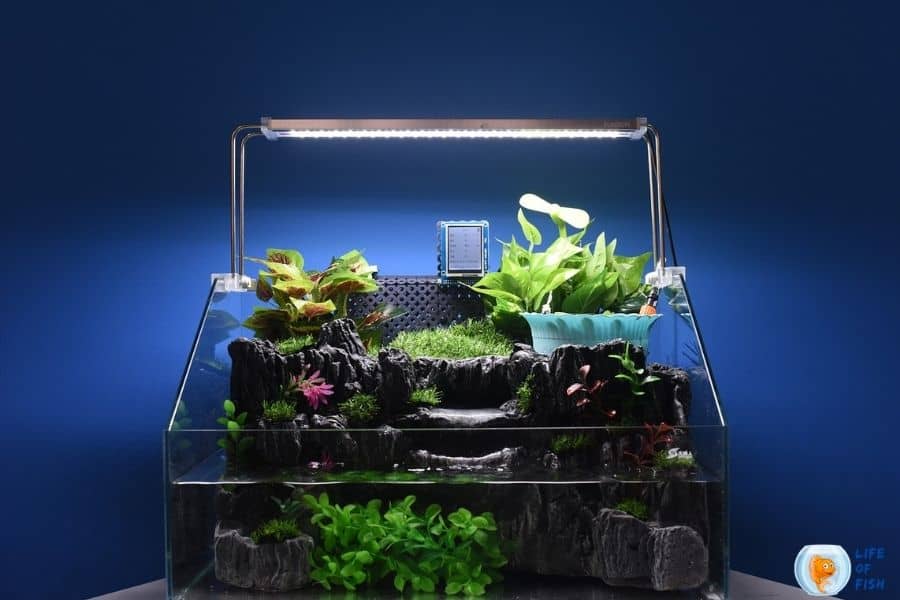
What Is A Half water half land aquarium ?
Jump To
- 1 What Is A Half water half land aquarium ?
- 2 How Do You Make A Half water half land aquarium?
- 3 Select A Design
- 4 Setting up
- 5 Half water half land aquarium Kit
- 6 Animals For Half Water Half Land Aquarium
- 7 Paludarium Plant life
- 8 Paludarium Waterfall
- 9 Do You Need A Filter For A Paludarium?
- 10 How Do You Keep Paludarium Water Clean?
- 11 Is Paludariums Hard To Maintain?
- 12 How Do You Prevent Mold In Paludarium?
- 13 What Is The Difference Between A Vivarium And A Paludarium?
- 14 How Much Does A Paludarium Cost?
- 15 Conclusion
Did you ever hear the word “paludarium” before? There is a Latin word “palus,” and its meaning is marsh or swamp. Further, there is a suffix “arium,” and It means that location or receptacle. So, these words generate the word “paludarium.” So the Half water half land aquarium is known as the paludarium. Simply you can guess the nature of the paludarium with its name. It is a semi-aquatic habitat.
Both land and water play a significant role to creates a natural environment in the paludraium. Generally, the typical aquarium setup does not have land structures. It gives more attention to the water. However, if you want to simple definition for half land half water aquarium, simply paludarium is a living art.
This concept tries to bring rainforests, wetlands, and stream sensations into the fish tank. This tries to bring a natural feeling to both hobbyists and aquatic creatures. Also, this is the best choice for hobbyists who love to try new things. The paludarium creates a beautiful and unique view by combining both land and aquatic life.
How Do You Make A Half water half land aquarium?
when you set up a paludarium, you should highly consider several things. So, let’s see them one by one.
Choose The Tank
Imagine, you need to buy a tank for your betta fish. Surely, at that time, you worry about so many features of the tank. But, why? Yes, you need to choose the best tank. Here it is also the same. You may have doubts about what are the features that should consist of a tank to prepare a paludarium. However, there is no exact answer. It depends on what you want to keep in the paludarium tank. So, when you choose a tank for a paludarium, you should consider these factors.
Animal species You Wish To Rear
Generally, beginners make common mistakes when selecting a tank for the first time. Before purchasing, they do not think about the fish and other creatures they want to keep in a tank. But the best thing is, first to think about what inhabitants you like to keep in your paludarium tank. It will help to decide the size of your tank.
The Layout Of The Desired Paludarium Aquarium
It would be best to consider the layout you want to set up in the paludarium aquarium.
If You Wish To Set Up A Waterfall Or Not
Most hobbyists like to set up a waterfall in their paludarium. So, at that time, you have to decide on enough height and depth to create it. Usually, if you like to set a waterfall, you should go for at least 10 gallons tank. Exceptionally, you can set up a small waterfall in a 5-gallon tank too. There is no specific tank to create a paludarium. But these are my opinion due to my experience.
- If you like to Countertop paludarium, it is better to select a small aquarium or Nano paludarium tank
- A small tabletop paludarium is ideal for beginners. Because it is easy to manage at the start-up level. So, you can choose a 5-gallon tank as a beginner.
- If you want to set up a larger paludarium, a 50-gallon tank is ideal
The large tanks have plenty of space to create your paludarium and add a diverse collection to it.
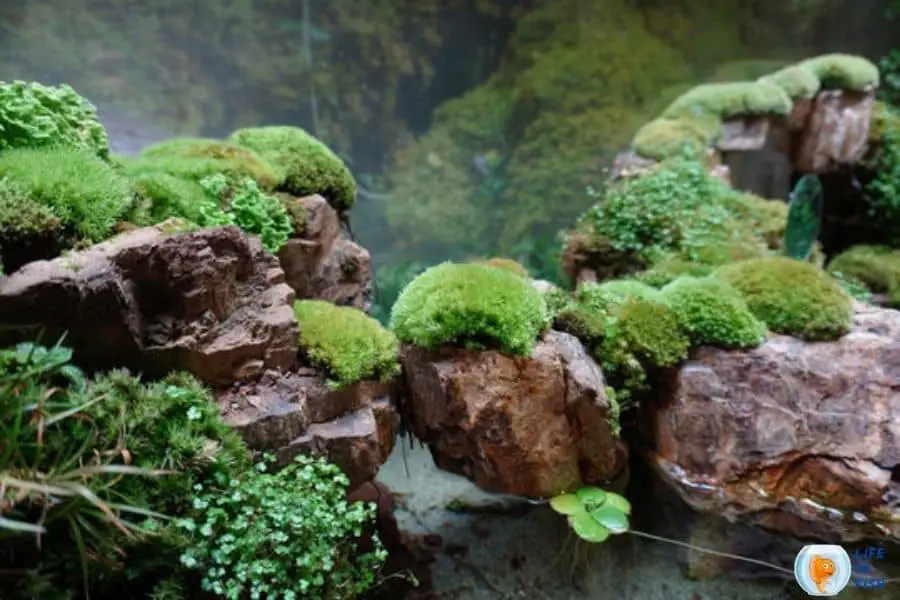
Select A Design
Substrate Type
Generally, if you use epiphyte plants, it is not essential to have a substrate. But even so, you can use substrate for aesthetical purposes. Here, you can use sand, small rocks, coarse gravel, or crushed lava rocks as a substrate for the submerged part of the paludarium. Moreover, you can attach or tie the epiphyte plants in driftwoods and rocks.
Additionally, you can use regular garden soil as a substrate. This substrate is more suitable if you like to go with terrestrial or non-epiphyte plants. But the soil may cause to cloud the water. Therefore, you should be highly concerned about isolating the soil part from the water. If you do not want to deal with trouble anymore, you can use aqua soil. Some hobbyists prefer to grow the Cryptocoryne sp., Amazon Swords, and some Aponogeton sp. In this case, you can use potting or garden soil top with inert Belge or black sand.
Setting up
First of all, if you are a beginner, starting with a smaller tank is better. Once you have some experience, then you can create a large tank. But it is up to you. When creating a paludarium, you must never forget that your layout replicates the natural environment. So, it would be best if you decided on everything to achieve that aim. Let’s check how to achieve it step by step.
Step 1: Clear Idea About The Layers Of Paludarium
So, before you set up a paludarium, what are the basic things you should know? Basically, you should think about the layers of the paludarium. Guess!
- The canopy
Simply, the canopy is the top area or layer of the tank. It includes rocks, branches, and tall live plants. This is the best area for land-dwelling inhabitants because the canopy provides shelter and shade for them.
- The land
This area is the ideal place for your terrestrial plants. Further, you should build this area before adding the water. Also, you can make the land area with rocks, soil, sand, and wood. But basically, it depends on what plants you have to grow in this area.
- The water
The water part is very familiar to you as an aquarist. Because this part resembles the typical aquarium. The water column provides a habitat for all aquatic life. Also, this part helps to elevate the humidity levels.
Step 2: Initial Planning
You should have a plan or mind map about where the land area and water portion you set up in the paludarium.
Phase 1: Separate the water and land of paludarium
Physically, this is the first thing that you should do when building the setup. There are a few different ways to separate the water and the land. Most hobbyists use a divider. Generally, a divider makes a barrier to separate these layers. Simply one half of the tank can be water, and another half will be land.
So, what are these dividers? Most probably dividers are plexiglass because it is safe to use for your paludarium. But you can use any waterproof and aquarium-safe material other than plexiglass. Another doubt is, how do you secure the barrier to the tank wall? It is easy with aquarium-safe silicone. Also, it will help to provide a leak-proof barrier. Moreover, you can use another alternative. But make sure they are safe in your paludarium.
Phase 2: Start to build the land area
You can use rocks, wood, soil, and sand. If you want to create raises in the land part, you can use upside-down bowls or pots. Here, before you add ornaments, think about how hard to remove and cleaning and these things when they trap debris. In addition to that, how do you hold these things together? Foam sealant is the solution. Also, it helps to carve into the preferable shape. Another important thing is, that there should be a drain at the bottom of the land portion. Because it helps to prevent flooding during the water level gets too high.
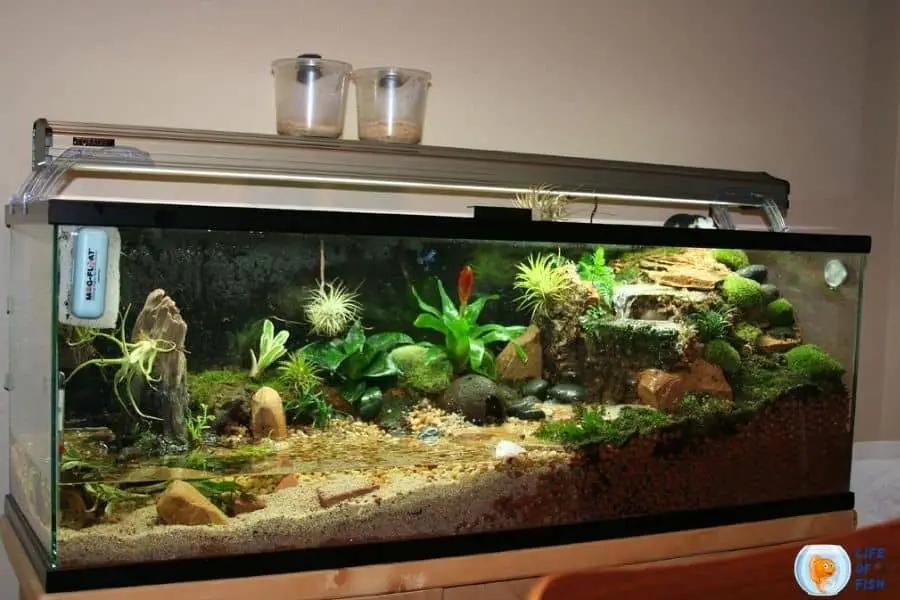
Phase 3: Plants the suitable live plants
Here you should select the suitable plants for your paludarium. For instance, decide which plant species can tolerate the proximity of the water portion. And which plant species can add to the top layer of the paludarium.
Phase 4: Set up the water portion
Water portion help to control the humidity. Here, you should concern about all elements of a regular aquarium, such as correct water conditions, filtration, etc. When comes to filtration, some hobbyist relies solely on live plants for filtration. But on the other hand, some hobbyists use small filters that can submerge. Another important thing is you should cycle the water before adding animals into the paludarium.
Phase 5: An in-between area
This is the best place for terrestrial animals. You can create a floating shelf over the water. Typically, PVC plastic is used to create a shelf. Also, you can use silicone or aquarium-safe glue to attach to the sides of the tank. On the other hand, supports help to hold the shelf in place. If not, you can use flat pieces of cork or driftwood as alternatives. Further, as a result of growing moss on this floating shelf, this area provides the food and substrate for the animals in the tank.
Phase 6: Optional waterfall set in the paludarium
At present, the waterfall is a common feature in the paludarium. It adds additional value to the paludarium. But if you do not prefer to set up a waterfall, you can skip this step.
Special Note: After properly cycling the water portion, you can add the animals. However, my recommendation is, that before adding any animals, you can take about 14 days to test your paludarium. During this time, plants can properly root in and adjust to the enclosure. Also, in this testing time, you can identify some errors. For instance, if you place a plant that does not match, you can quickly move it. So, after this testing period, if you are happy with the plants’ growth, lighting, filtration, and heating, you can add your fish and other animals to the paludarium.
Half water half land aquarium Kit
There are different paludarium kits in the market. Also, these are equipped with many basics to save build time and ease your work.
- The AquaTerrium Planting Tank By Penn Plax
- Zoo Med Paludarium Habitat Kit
- Zoo Med Paludarium Double Door kit
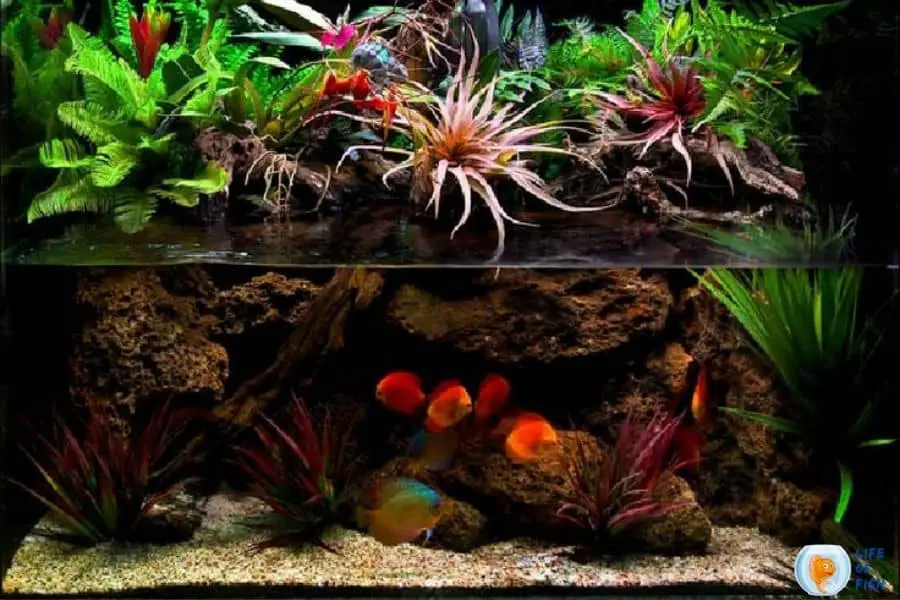
Animals For Half Water Half Land Aquarium
Most hobbyists need to add a mix of terrestrial animals and aquatic animals to their Paludarium. That is because they need to add more color to their tank by diversifying the environment. But before you select the animals for your Paludarium, you should be aware of what species can be partners. So, you can create your collection with the below-mentioned species.
Freshwater Fish species
Generally, you can add freshwater fish species. But you should ensure the species have similar requirements for water conditions like temperature, hardness, and pH level. Also, it is better to choose a fish species that do not show aggressive behaviors towards other species.
- Killifish
- Angelfish
- Mollies
- Guppies
- Cichlids
- Danios
- Gouramis
- Glowlight tetras
- Cardinal tetras
- Ember tetras
- Chili rasboras
- Harlequin
Special Note: Some hobbyists keep only a couple of these species in their Paludarium to achieve a tidier look. But it is up to you and the space.
Shrimps
Freshwater shrimps add unique value to your Paludarium, and they are a natural cleaning crew. Shrimps help to graze and eat plant matter and debris in your tank. But they produce little waste.
- Cherry shrimp
- Ghost shrimp
- Amano shrimp
Snails
Snails provide an elegant look while cleaning your tank. So, you can choose suitable freshwater snails.
- Mystery snails
- Nerite snails
- Ramshorn snails
Semi-aquatic animals
- Frogs and toads – Green frog and dart frogs
- Turtles – Painted sliders
- Salamanders – American tiger salamander
- Newts – Pacific and fire-bellied newts
- Water dragons
- Mudskippers
- fiddler crabs
Special note : You should research before introducing a new animal or plant into your paludarium because you should know which animals/ plants you can keep together and harmoniously with each other.
Paludarium Plant life
Typically, there are lots of plants that can be part of your paludarium. So, you can choose them under these three types.
- Terrestrial plants
- Semi-aquatic plant species
- Aquatic plant species
However, when you choose a plant for your paludarium, you should consider several factors.
- How much time that you have to maintain and look after your paludarium? For instance, many people choose slow-growing plants.
- The space of the tank
- What is the ultimate view of your paludarium
However, I listed below some plant species for decorating your paludarium.
- Creeping plants and vines – devil ivy and creeping fig – this plant is ideal for covering the tank’s back walls.
- Ferns – boston ferns, holly ferns and lemon button ferns
- Mosses – java moss
- Bromeliads – this species is an ideal addition for frogs, and you can choose them from different sizes
- Orchids – it is better to go with smaller species. But you have to pay extra attention to orchids.
- Flowering plants – dracaena, peace lilies, and crotons
- Pothos – this species gives a neat feel and look to your tank
- Floating plants – Salvinia and floating fern
- Aquatic plants – Anubis, java ferns, and cryptocoryne
Special note: When you select plants, you should be highly aware of them. Thus some plants can be harmful to some animals in your paludarium. Further, some plants are food for animals. Therefore you have to replenish.
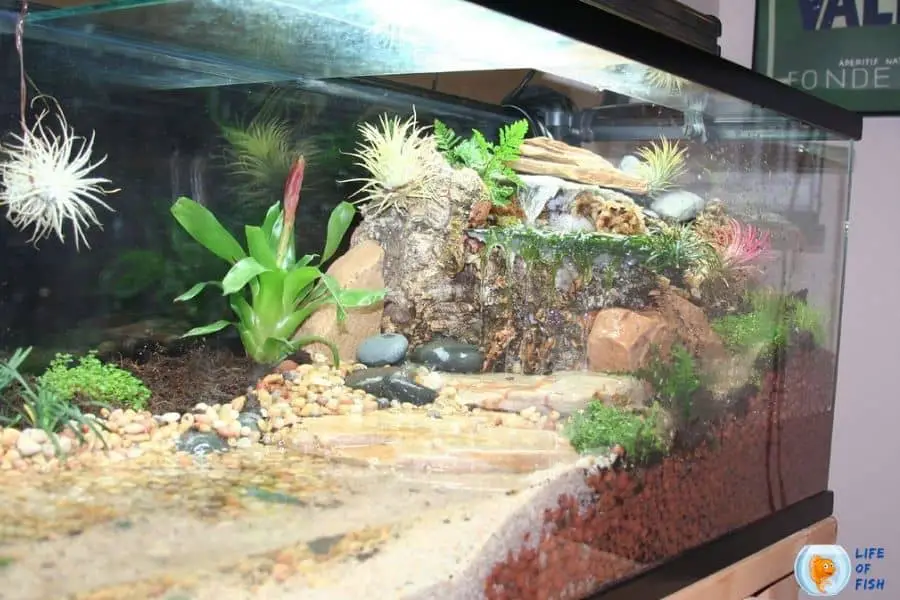
Paludarium Waterfall
Paludarium waterfall can create by pumping the aquarium water to the top of the waterfall. However, you can use the filter to do this. Further, it would be best if you placed the inlet at the top of the waterfall. Additionally, you can build a surface with rocks, woods, and slate to flow down the waterfall.
Do You Need A Filter For A Paludarium?
You need a filter if you wish to rear fish or aquatic invertebrates like snails and shrimps in your paludarium. Further, if you want to add extra value and beauty to your paludarium, of course, you need a filter. However, it is better to select a properly sized filter like a Canister filter or HOB filter.
How Do You Keep Paludarium Water Clean?
Typically, a better filtration system plays a vital role in keeping paludarium water clean. Therefore, you should select an appropriate filter for your paludarium.
Is Paludariums Hard To Maintain?
As a general idea, setting up a paludarium is difficult. But comparatively, maintaining and looking after a paludarium is easy than that. The thing you should do is maintain good tank hygiene and conditions. So, if you have proper knowledge and time, keeping and maintaining the paludarium is easy.
How Do You Prevent Mold In Paludarium?
- Avoid overfeeding and adequately feeding your animals. So, you should know the ideal amount of food that suits the animals in your paludarium.
- You can use charcoal with soil. Charcoals discourage the growth of mold in the paludarium.
- You should place fresh and hardy plants in a paludarium.
- Also, you must remove dead matters quickly.
What Is The Difference Between A Vivarium And A Paludarium?
A vivarium is any captivity space or place that has animals/ plants with mimic conditions in nature. Basically, if you have an aquarium or terrarium, these two are also a part of a vivarium. But over time, peoples tend to call reptile tanks the vivarium. On the other hand, a paludarium is a terrarium with a water portion. Simply it is a combination of aquatic and terrestrial.
How Much Does A Paludarium Cost?
The paludarium tank’s cost varies with the size of the tank, fish and crustacean species, plant species, filter system, etc. Generally its ranges from $50 to $400.
Conclusion
Paludarium is a small paradise on your premises. Actually, it is an aquarium with terrestrial features. You can follow the guidelines and build a wonderful paludarium. Your finders have magic, and your mind has blessings. So, keep them together to achieve your dream paludarium!
Read Next: Can Snails Get Ich? Or Do They Spread Ich? | Find The Answer In 5 Minutes |
